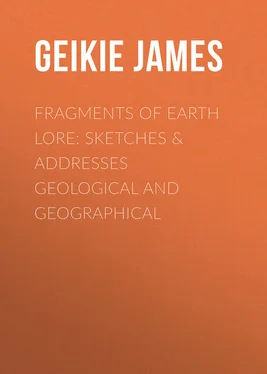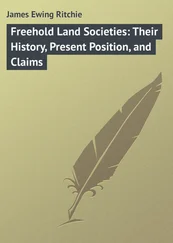James Geikie - Fragments of Earth Lore - Sketches & Addresses Geological and Geographical
Здесь есть возможность читать онлайн «James Geikie - Fragments of Earth Lore - Sketches & Addresses Geological and Geographical» — ознакомительный отрывок электронной книги совершенно бесплатно, а после прочтения отрывка купить полную версию. В некоторых случаях можно слушать аудио, скачать через торрент в формате fb2 и присутствует краткое содержание. Жанр: foreign_antique, foreign_prose, на английском языке. Описание произведения, (предисловие) а так же отзывы посетителей доступны на портале библиотеки ЛибКат.
- Название:Fragments of Earth Lore: Sketches & Addresses Geological and Geographical
- Автор:
- Жанр:
- Год:неизвестен
- ISBN:нет данных
- Рейтинг книги:4 / 5. Голосов: 1
-
Избранное:Добавить в избранное
- Отзывы:
-
Ваша оценка:
- 80
- 1
- 2
- 3
- 4
- 5
Fragments of Earth Lore: Sketches & Addresses Geological and Geographical: краткое содержание, описание и аннотация
Предлагаем к чтению аннотацию, описание, краткое содержание или предисловие (зависит от того, что написал сам автор книги «Fragments of Earth Lore: Sketches & Addresses Geological and Geographical»). Если вы не нашли необходимую информацию о книге — напишите в комментариях, мы постараемся отыскать её.
Fragments of Earth Lore: Sketches & Addresses Geological and Geographical — читать онлайн ознакомительный отрывок
Ниже представлен текст книги, разбитый по страницам. Система сохранения места последней прочитанной страницы, позволяет с удобством читать онлайн бесплатно книгу «Fragments of Earth Lore: Sketches & Addresses Geological and Geographical», без необходимости каждый раз заново искать на чём Вы остановились. Поставьте закладку, и сможете в любой момент перейти на страницу, на которой закончили чтение.
Интервал:
Закладка:
The Great Glen, as I mentioned in the preceding article, coincides with a fracture or dislocation – a line of weakness along which the denuding agents had worked for many ages before the beginning of Old Red Sandstone times; and it is possible that smaller dislocations may yet be detected in other valleys. But in each and every case the valleys as we now see them are valleys of erosion; in each and every case the mountains are mountains of circumdenudation; they project as eminences because the rock-masses which formerly surrounded them have been gradually removed. We have only to protract the outcrops of the denuded strata – to restore their continuations – to form some faint idea of the enormous masses of rock which have been carried away from the surface of the Highland area since the strata were folded and fractured. All this erosion speaks to the lapse of long ages. The mountains of elevation which doubtless at one time existed within the Highland area had already, as we have seen, suffered extreme erosion before the beginning of Old Red Sandstone times, much of the area having been converted into an undulating plateau or plain, which, becoming submerged in part, was gradually overspread by the sedimentary deposits of the succeeding Old Red Sandstone period. Those sediments were doubtless derived in large measure from the denudation of the older rocks of the Highlands, and since they attain in places a thickness of 20,000 feet, and cover many square miles, they help us to realise in some measure the vast erosion the Highland area had sustained before the commencement of the Carboniferous period. Nor must we forget that the Old Red Sandstone formation which borders the Highlands has itself experienced excessive denudation: it formerly had a much greater extension, and doubtless at one time overspread large tracts of the Highlands. Again, we have to remember that during the Carboniferous and Permian periods, and the later Mesozoic and Cainozoic eras, the Highlands probably remained more or less continuously in the condition of land. Bearing this in mind, we need not be surprised that not a vestige of the primeval configuration brought about by the great earth-movements of late Silurian times has been preserved. Indeed, had the Highland area, after the disappearance of the Old Red Sandstone inland seas, remained undisturbed by any movement of elevation or depression, it must long ago have been reduced by sub-aërial erosion to the condition of a low-lying undulating plain. But elevation en masse from time to time took place, and so running water and its numerous allies have been enabled to carry on the work of denudation.
Thus in the geological history of the Scottish Highlands we may trace the successive phases through which many other elevated tracts have passed. The Scandinavian plateau, and many of the mountains of middle Germany – such, for example, as the Harz, the Erzgebirge, the Thüringer-Wald, etc. – show by their structure that they have undergone similar changes. First we have an epoch of mountain-elevation, when the strata are squeezed and crushed laterally, fractured and shattered – the result being the production of a series of more or less parallel anticlines and synclines, or, in other words, a true mountain-chain. Next we have a prolonged period of erosion, during which running water flows through synclinal troughs, works along the backs of broken and shattered anticlines, and makes its way by joints, gaping cracks, and dislocations, to the low grounds. As time goes on, the varying character of the rocks and the mode of their arrangement begin to tell: the weaker structures are broken up; rock-falls and landslips ever and anon take place; anticlinal ridges are gradually demolished, while synclines tend to endure, and thus grow, as it were, into hills, by the gradual removal of the more weakly-constructed rock-masses that surround them. Valleys continue to be deepened and widened, while the intervening mountains, eaten into by the rivers and their countless feeders, and shattered and pulverised by springs and frosts, are gradually narrowed, interrupted, and reduced, until eventually what was formerly a great mountain-chain becomes converted into a low-lying undulating plain. Should the region now experience a movement of depression, and sink under the sea, new sedimentary deposits will gather over its surface to a depth, it may be, of many hundreds or even thousands of feet. Should this sunken area be once more elevated en masse – pushed up bodily until it attains a height of several thousand feet – it will form a plateau, composed of a series of horizontal strata resting on the contorted and convoluted rocks of the ancient denuded mountain-chain. The surface of the plateau will now be traversed by streams and rivers, and in course of time it must become deeply cleft and furrowed, the ground between the various valleys rising into mountain-masses. Should the land remain stationary, its former fate shall again overtake it; it will inevitably be degraded and worn down by the sub-aërial agents of erosion, until once more it assumes the character of a low-lying undulating plain.
Through such phases our Highlands have certainly passed. At a very early epoch the Archæan rocks of the north-west were ridged up into great mountain-masses, but before the beginning of the pre-Cambrian period wide areas of those highly-contorted rocks had already been planed across, so that when subsidence ensued the pre-Cambrian sandstones were deposited upon a gently undulating surface of highly convoluted strata. Another great epoch of mountain-making took place after Lower Silurian times, and true mountain-ranges once more appeared in the Highland area. We cannot tell how high those mountains may have been, but they might well have rivalled the Alps. After their elevation a prolonged period of erosion ensued, and the lofty mountain-land was reduced in large measure to the condition of a plain, wide areas of which were subsequently overflowed by the inland seas of Old Red Sandstone times – so that the sediments of those seas or lakes now rest with a violent unconformity on the upturned and denuded edges of the folded and contorted Silurian strata. At a later geological period the whole Highland area was elevated en masse , forming an undulating plateau, traversed by countless streams and rivers, some of which flowed in hollows that had existed before the beginning of Old Red Sandstone times. Since that epoch of elevation the Highland area, although subject to occasional oscillations of level, would appear to have remained more or less continuously in the condition of dry land. The result is, that the ancient plateau of erosion has been deeply incised – the denuding agents have carved it into mountain and glen – the forms and directions of which have been determined partly by the original surface-slopes of the plateau, and partly by the petrological character of the rocks and the geological structure of the ground.
Thus, in the evolution of the surface-features of the earth, the working of two great classes of geological agents is conspicuous – the subterranean and the sub-aërial. The sinking down of the crust upon the cooling nucleus would appear to have given rise to the great oceanic depressions and continental ridges, just as the minor depressions within our continental areas have originated many mountain-chains. In the area undergoing depression the strata are subjected to intense lateral pressure, to which they yield along certain lines by folding up. The strata forming the Alps, which are 130 miles broad, originally occupied a width of 200 miles; and similar evidence of enormous compression is conspicuous in the structure of all mountains of elevation. Great elevation, however, may take place with little or no disturbance of stratification: wide continental areas have been slowly upheaved en masse , and sea-bottoms and low-lying plains have in this way been converted into lofty plateaux. 6 6 This is the generally accepted view of modern geologists. It is very difficult, however, to understand how a wide continental area can be vertically upheaved. It seems more probable that the upheaval of the land is only apparent. The land seems to rise because the sea retreats as the result of the subsidence of the crust within the great oceanic basins. See Article xiv. (1892.)
Many of the most conspicuous features of the earth’s surface, therefore, are due directly to subterranean action. All those features, however, become modified by denudation, and eventually the primeval configuration may be entirely destroyed, and replaced by contours which bear no direct relation to the form of the original surface. In the newer mountain-chains of the globe the surface-features are still largely those due directly to upheaval; so in some recently elevated plateaux the ground has not yet been cut up and converted into irregular mountain-masses. Many of the more ancient mountain-chains and ranges, however, have been exposed so long to the abrading action of the denuding agents that all trace of their original contour has vanished. And in like manner plateaux of great age have been so highly denuded, so cut and carved by the tools of erosion, that their plateau character has become obscured. They have been converted into undulating mountainous and hilly regions. Everywhere throughout the world we read the same tale of subsidence and accumulation, of upheaval and denudation. The ancient sedimentary deposits which form the major portion of our land-surfaces, are the waste materials derived from the demolition of plains, plateaux, and mountains of elevation. In some mountain-regions we read the evidence of successive epochs of uplift, separated by long intervening periods of erosion, followed by depression and accumulation of newer sediments over the denuded surface. Thus the Alps began to be elevated towards the close of Palæozoic times. Erosion followed, and subsequently the land became depressed, and a vast succession of deposits accumulated over its surface during the long-continued Mesozoic era into early Cainozoic times. Again, a great upheaval ensued, and the Mesozoic and Eocene strata were violently contorted and folded along the flanks of the chain. Then succeeded another period of erosion and depression, which was again interrupted by one or more extensive upheavals. Away from those lines of weakness which we call mountain-chains, we constantly encounter evidence of widespread movements of elevation, during which broad areas of sea-bottom have been upheaved to the light of day, and, after suffering extensive denudation have subsided, to be again overspread with the spoils of adjacent lands, and then upheaved once more. And such oscillations of level have occurred again and again. Looking back through the long vista of the past, we see each continental area in a state of flux – land alternating with sea, and sea with land – mountains and plateaux appearing and disappearing – a constant succession of modifications, brought about by the antagonistic subterranean and sub-aërial agents.
Интервал:
Закладка:
Похожие книги на «Fragments of Earth Lore: Sketches & Addresses Geological and Geographical»
Представляем Вашему вниманию похожие книги на «Fragments of Earth Lore: Sketches & Addresses Geological and Geographical» списком для выбора. Мы отобрали схожую по названию и смыслу литературу в надежде предоставить читателям больше вариантов отыскать новые, интересные, ещё непрочитанные произведения.
Обсуждение, отзывы о книге «Fragments of Earth Lore: Sketches & Addresses Geological and Geographical» и просто собственные мнения читателей. Оставьте ваши комментарии, напишите, что Вы думаете о произведении, его смысле или главных героях. Укажите что конкретно понравилось, а что нет, и почему Вы так считаете.












